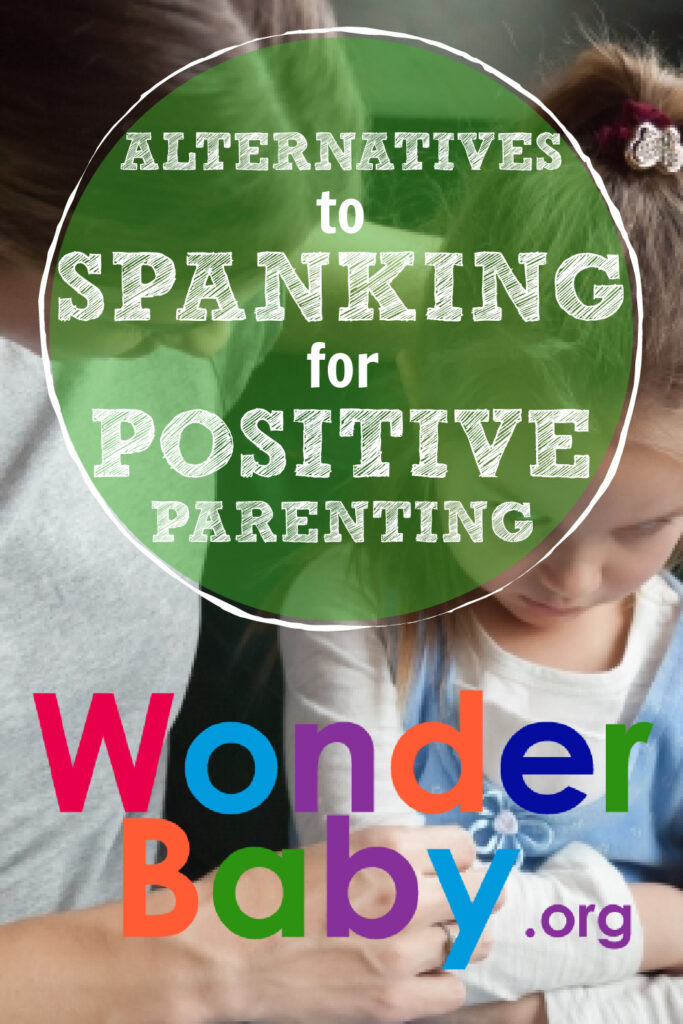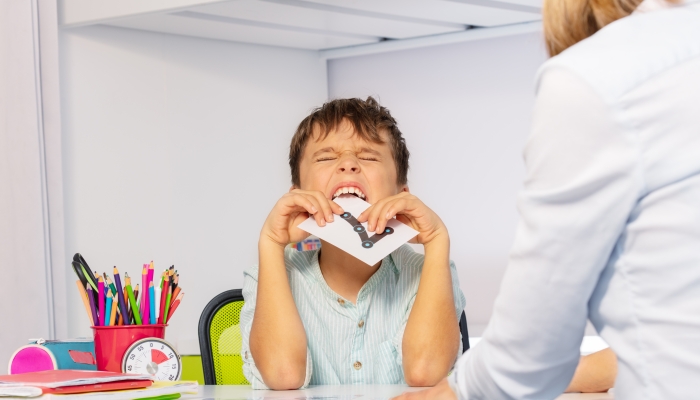7 Alternatives to Spanking for Positive Parenting

- Children of every age will benefit from positive parenting approaches, like positive reinforcement and natural consequences.
- Connecting with your child through empathy while setting firm yet kind boundaries will create a trusting, respectful relationship with him.
- Most tantrums are caused by a lack of skills or ability to communicate. Helping your child build their coping skills will decrease the need for punishing “bad behavior”.
Many parents are choosing not to spank due to sufficient evidence that corporal punishment is harmful to the brain development of young children. However, they feel lost on how to discipline their children without the use of anger and spanking.
Below are seven alternatives to spanking that you may find helpful for teaching children appropriate boundaries, life skills, and communication strategies.
1. Connection Before Correction
“Connection before correction” means making the relationship with your child the #1 priority. Meaning you do not prioritize being right, getting your way, or demanding respect. It is offering empathy while holding tight to house rules and enforcing boundaries.
Connecting with your child is an important part of positive parenting. Once you have the relationship with your child set as a priority, then determining other forms of discipline gets easier.
Examples of Connection Before Correction:
“I know you’re disappointed. I said ‘No’ to buying a new toy today. I’d like to give you a hug when you’re ready.”
“I did feel sad and angry when my vase got broken but I love you no matter what. I know it was just an accident.”
2. Positive Reinforcement
Positive reinforcement is a type of discipline that strengthens positive behaviors through the presentation of a reward.
Examples of Positive Reinforcement
“You shared your toys without being told. Thank you! You can pick a sticker from the drawer.”
“When you get your pajamas on quickly, I’ll let you pick the book to read.”
Practicing Positive Reinforcement
- Set the expectation beforehand: “I’d like you to please pick up all the toys off the living room floor.”
- Strengthen their positive behavior by offering a reward: “When you’re done picking up your toys, we can sit down and watch your favorite show together.”
- Set boundaries where necessary: “I see you got distracted when picking up your toys. Remember, we can watch your favorite show together when you are finished.”
- Provide the reward as soon as the task is completed for the best results. Delaying the reward will lessen your child’s motivation.
There are plenty of ways to enforce positive discipline. Really anything that your child finds pleasurable and is reasonable can be used. Many people think of giving physical rewards, but praise works just as well.

Using Positive Reinforcement for Discipline
- Hug or kiss
- High five
- Favorite treat
- Screen time
- Trip to a favorite location (zoo, park, library, etc.)
- Dance party
- Choosing their favorite book for storytime
- Encouraging words (“Great job!”, “You’re so responsible”, “See how good it feels to have a clean room!?” etc.)
3. Natural Consequences
Natural consequences are negative things that happen to your child based upon their behavior or choice without any parental involvement. These consequences can come from peers, nature, or other adults.
Examples of Natural Consequences
“If you wear shorts today, you will be cold. I’d like it if you wore long pants, but the choice is up to you.”
“You forgot your homework at home, so now you don’t get a prize at school.”
“It took you too long to get ready for the pool and now it is closed. We will have to try to be faster next time!”
When enforcing a natural consequence, a risk assessment must be done first. As the parent, you must determine if the lesson from the choice your child may make it worth the lesson it will provide.
Not intervening when your child misses the bus and letting them have the consequence of walking to school is a great lesson for older kids who are responsible enough to do so. But for younger kids, this consequence could be too risky and unsafe, especially if a dangerous highway or intersection is involved.
Assessing the risk is essential.
Once the risk has been assessed and it is determined that the lesson is worth the consequence, then all you do as the parent is sit back and let life happen. It is a win-win.
It is important to be non-judgmental when processing a natural consequence with your child. Instead, remain empathetic and matter-of-fact. Try not to make a lecture out of it.
“You look pretty cold. I bet that is no fun! Was the temperature outside too chilly to wear shorts? What do you think you should do next time it’s chilly outside?
Processing why the consequence occurred and how to avoid it again next time is the most essential part of ensuring the successfulness of natural consequences.
4. Logical Consequences
Logical consequences are when a child’s decision or behavior leads to the intervention of a parent with the intention to teach the child that every action has a reaction.
”You snuck candy after dinner. We set limits on candy to help keep you healthy and to ensure you have a balanced diet. So since you made the choice to eat too much candy, now you will have to take a break from candy until the weekend.”
With arbitrary consequences, the punishment doesn’t match the crime. The consequence determined by the parent is not related to the negative behavior, or too much time has passed to teach the lesson.
“You snuck candy after dinner yesterday so now you have to sit in time out for 10 minutes.”
Spanking is an example of an arbitrary consequence.
“You hit your sister so now your punishment is to be spanked.” Responding to hitting with a physical punishment sends a mixed message. Spanking teaches children to respond with violence.
“I won’t let you hurt your sister. Since you’ve hit her twice this afternoon, you will have to go play in your room by yourself until dinner time.”

5. Calm Down Time
This technique is an alternative to time outs.
“Time out” is a punishment technique – reprimanding a kid for “bad” behavior.
“Calm Down time”, also referred to as “time in”, is intended more as a skills-building technique. It is a time offered to your child for them to separate from the stimulating and emotionally charged environment. This break provides them time to practice their skills of calming their mind and body.
Practicing “Calm Down Time”
- Start by creating a space for your kid that is quiet and soothing. It needs to be close to you but not in the same room.
- Provide soothing objects, such as a loved blanket, stuffed animal, quiet music, and/or soft lighting.
- Explain to your child what the intention of the space is. Do this before you need to use it, at a time when the child is calm and receptive.
- Then when you notice your child is emotionally charged (i.e. tantruming, screaming, fighting, or crying more than usual), usher them to the space and encourage them to use the time and tools to calm down their body and mind. Say, “I can tell you are very upset right now. It sounds like you need to take some time to calm down. Let’s go to your calm down spot for a little bit.”
- Stay calm and reassuring:” I know you are feeling angry with Mommy for saying ‘No’.”
- If you are able, stay with your child and practice “time in”. Stay in their presence while they are upset to help guide them to a calm state and offer acceptance.
- If you need to step away because of your own anger or if he is trying to harm you, leave the door open. Shutting them out will increase the sense of disturbance.
- Model for them how to take a deep breath. “Can you blow out my pretend birthday candle?” “Notice how your body feels better when you take a deep breath?”
- Discuss what caused the intense emotion after the child has returned to a calm state. Avoid lecturing.
6. Skills Building
“Discipline is helping a child solve a problem. Punishment is making a child suffer for having a problem. To raise problem solvers, focus on solutions, not retribution.” – L.R. Knost
Parents are first and foremost, teachers. We teach our kids through modeling, correcting, and through skills building.
When teaching a baby to walk, you first show them how to walk by walking yourself. They observe your behavior and work to mimic you. Then as your child grows, they will begin trying to take their first steps. You encourage this behavior by holding their hands, picking them up when they fall, and clapping when they finally get it.
It is the same process for any other skill you want to teach your child, even the most strong-willed child will benefit!
Using Skills Building as Discipline
Does he argue with his sister often? Teach him conflict resolution skills.
“I hear you are fighting over that toy. Can you ask her if she will give it to you when she’s done playing? Maybe see if she can be done in five or ten minutes? Or offer to trade her for a toy she likes to play with?”
Does she often throw fits when she doesn’t get her way? Teach her coping skills.
“I know it is really disappointing when I tell you ‘No’. I like to cry a little and then take deep breaths or go for a walk when I am disappointed. Want to try it?”
Does he talk to you “disrespectfully”? Teach him communication skills.
“You’d like me to get you something to drink? Can you try saying it ‘May I have some juice please?”
You will never regret taking the time to teach your child a skill in place of punishing them for not having the skills in the first place.
7. Redirection
It’s bedtime and your children seem ready to run a marathon instead of going to bed. You’re tired and can tell getting them ready for bed is going to be a fight, maybe even leading to bedtime tantrums.
This would be a great time to just redirect your child’s behavior!
“Kids, did you hear that?! I think there’s a monster outside ready to tickle any little kid who doesn’t have their PJs on!! You don’t hear it?? Well, I do! You’d better get your PJs on quickly or he’s going to come in here and tickle you!!”
Redirection is the skill of redirecting your focus from punishment for bad behavior to accomplishing a task instead. The goal is to get your kids ready for bed. You can get that done through yelling and punishing, which leaves a sense of frustration and guilt all around, or you can try redirecting into something more positive.
Making a boring task a fun one is a great way to use redirection. This is not only helpful for your child but helpful for you as well. It takes away the negative feeling of needing to “punish” and creates a sense of playfulness that can be very rewarding.
Redirection is also useful when your child is pursuing a negative behavior that is simply out of curiosity.
Examples of Redirection
“I see you’re banging your silverware on the table. Can you start handing out the napkins while Mommy finishes getting dinner ready?”
“We don’t want to put rocks in our pockets. They will get stuck in the washing machine that way. Can you put them in this bucket instead?”
Building Relationships > Bruising Feelings (or Bums)
The seven alternatives to spanking presented in this article are just skimming the surface of the positive parenting approach. Whether you are trying to eliminate spanking, time outs, or you just wish to yell less, I am confident some of these approaches will work for you.
Remember, it’s not about getting it right every time. It is about showing your children your relationship with them is a priority.

Related Posts

Behavior
Understanding Intermittent Explosive Disorder in Children
Are you worried about your child’s unexpected aggression and explosive behaviors? Learn how to support a child with intermittent explosive disorder.

Behavior
5 Emotional Regulation Activities for Kids
Want to teach your child how to regulate emotions? Here are emotional regulation activities for kids that can help!

Behavior, Special Needs
5 Tips for Dining Out with Children Who Have Sensory Sensitivities
Worried about dining out with sensory sensitivities? Try these tips for less stress and more fun the next time you take your family out to eat.